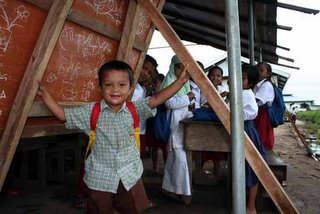Tsunami in Aceh & Nias, One Year After
 The tsunami and its aftermath demonstrated both the fragility of human life and the strength and generosity of the human spirit when we work together to begin again, former US president Bill Clinton and currently the UN Special Envoy for Tsunami Recovery wrote in an article Where we stand one year later published late last week by the International Herald Tribune.
The tsunami and its aftermath demonstrated both the fragility of human life and the strength and generosity of the human spirit when we work together to begin again, former US president Bill Clinton and currently the UN Special Envoy for Tsunami Recovery wrote in an article Where we stand one year later published late last week by the International Herald Tribune.Clinton put it right. One year later, around 100,000 people in Aceh and Nias alone, still live in unacceptable conditions and with minimal access to job opportunities.
Other humanitarian agencies reported half a million people are still homeless in Indonesia, however. Almost 100,000 houses will have to be built to accommodate them.
Indonesia's Rehabilitation and Reconstruction Agency (BRR) for Aceh and Nias planned to build 35 thousand units of new houses this year, but so far only 19,200 have been completed. It would take three more years to build more than 100,000 houses.
Meanwhile, Unicef survey shown that recovery on Indonesian kids influenced by the tsunami is the slowest among other countries hit by the catastrophe. The survey found one third of Indonesian kids believe their future would not be better off. Children in Aceh Jaya regency, for example, still studying in emergency school tents (photo courtesy of Acehkita.com)
Bureaucratic delays and concerns about corruption have stymied efforts to rebuild the communities destroyed in last year's tsunami.
There are more than 400 NGOs involved in Aceh aftermath of tsunami, but they are facing security problem in delivering humanitarian aids.
"When they brought in the food supplies, officers in uniform took it away. Sub-regency leaders even asked for fuels from NGOs and contractors," said Kuntoro Mangkusubroto, chairman of BRR.
Low quality of land available for housing complex is also a crucial problem. As a result, out of a commitment to build 13,364 units in West Aceh alone, only 625 units are completed. Habitat for Humanity, for example, committed to build 3,000 houses but only seven units completed.
Some 2500 teaching and non teaching staff died because of the tsunami. About 2000 schools were destroyed, leaving about 260,000 students without a place to learn. Rehabilitation of teaching facilities is simply not enough as many schools are lack of teachers.
INDONESIA'S military has announced plans to send more than 10,000 troops in Aceh to speed up tsunami reconstruction efforts.
But representatives of the Free Aceh Movement (GAM), which has staged a bloody 30-year independence struggle with the military, expressed alarm, stating the deployment would undermine a peace deal sined in August.
On top of that, few huge plants in North Aceh regency are struggling to survive and feared to be closed down soon due to scarcity of natural gas as raw materials. These plants are two fertilizer companies, PT Asean Aceh Fertilizer and PT Pupuk Iskandar Muda, with thousands of workers might lose their jobs. A higher jobless rate would worsen the overall situation in the fragile province.
Other humanitarian agencies reported half a million people are still homeless in Indonesia, however. Almost 100,000 houses will have to be built to accommodate them.
Indonesia's Rehabilitation and Reconstruction Agency (BRR) for Aceh and Nias planned to build 35 thousand units of new houses this year, but so far only 19,200 have been completed. It would take three more years to build more than 100,000 houses.
Meanwhile, Unicef survey shown that recovery on Indonesian kids influenced by the tsunami is the slowest among other countries hit by the catastrophe. The survey found one third of Indonesian kids believe their future would not be better off. Children in Aceh Jaya regency, for example, still studying in emergency school tents (photo courtesy of Acehkita.com)
Bureaucratic delays and concerns about corruption have stymied efforts to rebuild the communities destroyed in last year's tsunami.
There are more than 400 NGOs involved in Aceh aftermath of tsunami, but they are facing security problem in delivering humanitarian aids.
"When they brought in the food supplies, officers in uniform took it away. Sub-regency leaders even asked for fuels from NGOs and contractors," said Kuntoro Mangkusubroto, chairman of BRR.
Low quality of land available for housing complex is also a crucial problem. As a result, out of a commitment to build 13,364 units in West Aceh alone, only 625 units are completed. Habitat for Humanity, for example, committed to build 3,000 houses but only seven units completed.
Some 2500 teaching and non teaching staff died because of the tsunami. About 2000 schools were destroyed, leaving about 260,000 students without a place to learn. Rehabilitation of teaching facilities is simply not enough as many schools are lack of teachers.
INDONESIA'S military has announced plans to send more than 10,000 troops in Aceh to speed up tsunami reconstruction efforts.
But representatives of the Free Aceh Movement (GAM), which has staged a bloody 30-year independence struggle with the military, expressed alarm, stating the deployment would undermine a peace deal sined in August.
On top of that, few huge plants in North Aceh regency are struggling to survive and feared to be closed down soon due to scarcity of natural gas as raw materials. These plants are two fertilizer companies, PT Asean Aceh Fertilizer and PT Pupuk Iskandar Muda, with thousands of workers might lose their jobs. A higher jobless rate would worsen the overall situation in the fragile province.
READ MORE!!!


0 Comments:
Post a Comment
<< Home